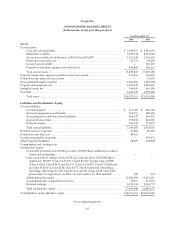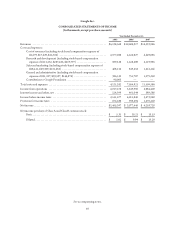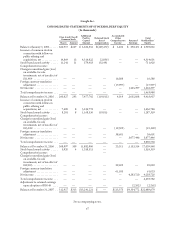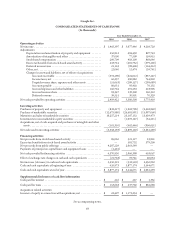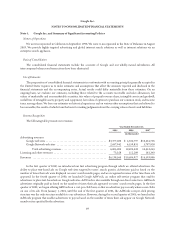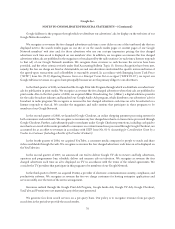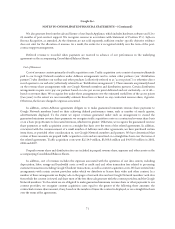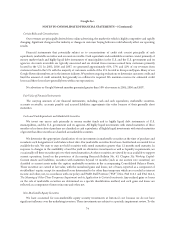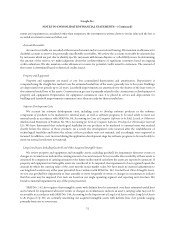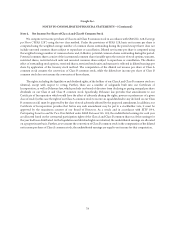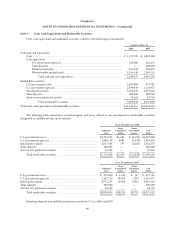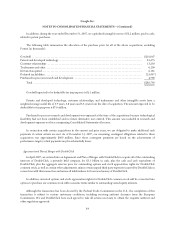Google 2007 Annual Report Download - page 89
Download and view the complete annual report
Please find page 89 of the 2007 Google annual report below. You can navigate through the pages in the report by either clicking on the pages listed below, or by using the keyword search tool below to find specific information within the annual report.Google Inc.
NOTES TO CONSOLIDATED FINANCIAL STATEMENTS—(Continued)
extent any impairment is considered other-than-temporary, the investment is written down to its fair value and the loss is
recorded as interest income and other, net.
Accounts Receivable
Accounts receivable are recorded at the invoiced amount and are non-interest bearing. We maintain an allowance for
doubtful accounts to reserve for potentially uncollectible receivables. We review the accounts receivable by amounts due
by customers which are past due to identify specific customers with known disputes or collectibility issues. In determining
the amount of the reserve, we make judgments about the creditworthiness of significant customers based on ongoing
credit evaluations. We also maintain a sales allowance to reserve for potential credits issued to customers. The amount of
the reserve is determined based on historical credits issued.
Property and Equipment
Property and equipment are stated at cost less accumulated depreciation and amortization. Depreciation is
computed using the straight-line method over the estimated useful lives of the assets, generally two to five years. Buildings
are depreciated over periods up to 25 years. Leasehold improvements are amortized over the shorter of the lease term or
the estimated useful lives of the assets. Construction in process is primarily related to the construction or development of
property and equipment. Depreciation for equipment commences once it is placed in service and depreciation for
buildings and leasehold improvements commences once they are ready for their intended use.
Software Development Costs
We account for software development costs, including costs to develop software products or the software
component of products to be marketed to external users, as well as software programs to be used solely to meet our
internal needs in accordance with SFAS No. 86, Accounting for Costs of Computer Software to be Sold, Leased, or Otherwise
Marketed and Statement of Position No. 98-1, Accounting for Costs of Computer Software Developed or Obtained for Internal
Use. We have determined that technological feasibility for our products to be marketed to external users was reached
shortly before the release of those products. As a result, the development costs incurred after the establishment of
technological feasibility and before the release of those products were not material, and accordingly, were expensed as
incurred. In addition, costs incurred during the application development stage for software programs to be used solely to
meet our internal needs were not material.
Long-Lived Assets Including Goodwill and Other Acquired Intangible Assets
We review property and equipment and intangible assets, excluding goodwill, for impairment whenever events or
changes in circumstances indicate the carrying amount of an asset may not be recoverable. Recoverability of these assets is
measured by comparison of carrying amounts to the future undiscounted cash flows the assets are expected to generate. If
property and equipment and intangible assets are considered to be impaired, the impairment to be recognized equals the
amount by which the carrying value of the asset exceeds its fair market value. We have made no material adjustments to
our long-lived assets in any of the years presented. In accordance with SFAS No. 142, Goodwill and Other Intangible Assets,
we test our goodwill for impairment at least annually or more frequently if events or changes in circumstances indicate
that this asset may be impaired. Our tests are based on our single operating segment and reporting unit structure. We
found no material impairment in any of the years presented.
SFAS No. 142 also requires that intangible assets with definite lives be amortized over their estimated useful lives
and reviewed for impairment whenever events or changes in circumstances indicate an asset’s carrying value may not be
recoverable in accordance with SFAS No. 144, Accounting for the Impairment of Long-Lived Assets and for Long-Lived Assets
to Be Disposed Of. We are currently amortizing our acquired intangible assets with definite lives over periods ranging
primarily from one to seven years.
75


